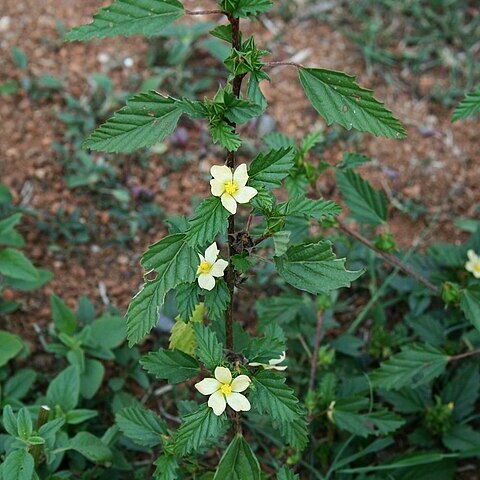Herbs or shrubs, the stems erect, the indumentum of simple or stellate or mal-pighiaceous hairs. Leaves petiolate, the blade serrate to deeply lobed or parted. Flowers axillary, solitary or glomerate, or in terminal, few-to many-flowered in- florescences, the individual flowers short-pedicellate to sessile; epicalyx of 3 distinct, narrow, persistent bractlets; calyx 5-lobed, accrescent and foliaceous in fruit; petals 5, obovate-cuneate,-more or less asymmetrically emarginate at the apex, connate at the base and adnate to the base of the staminal tube, yellow; staminal tube di-vided at the apex into few to numerous filaments, the anthers reniform; ovary of many, free, 1-ovulate carpels, the ovules erect or ascending; style branches isomer-ous with the carpels, filiform, the stigmas capitellate. Fruits discoid, composed of 1 whorl of mericarps, these hippocrepiform, incurved-rostrate to muticous, some-times with 1 apical and 2 dorsal awns, nearly indehiscent; seeds glabrous; endo-sperm scanty; cotyledons plicate.
Herbs perennial (sometimes annual) or subshrubs, erect. Leaves simple; stipules lanceolate or falcate; leaf blade ovate or lanceolate, entire or sometimes obscurely 3-lobed, margin crenate or dentate; foliar nectaries lacking. Flowers axillary, solitary or in cymose clusters, sometimes aggregated into terminal spikes. Epicalyx lobes 3, free, subulate or filiform to lanceolate. Calyx cup-shaped, 5-lobed. Corolla yellow or ± orange, broadly campanulate; petals 5, scarcely longer than calyx. Filament tube included within corolla, glabrous or puberulent; anthers clustered at apex. Ovary 5-18-loculed; ovules 1 per locule; styles as many as carpels, slender; stigmas capitate. Fruit a schizocarp, oblate; mericarps 5-18, indehiscent, reddish brown, horseshoe-shaped with a prominent ventral notch, sometimes 2-or 3-cuspidate. Seeds solitary, reniform, glabrous.
Bractlets of the epicalyx 3, narrowly linear; cal-lobes broadly ovate, persistent; stamen-column bearing anthers at the summit; pet yellow; carpels 5–many, separating at maturity and in our sp. dehiscent, 1-seeded, at maturity conforming with the shape of the seed and not much larger than it, the distal and basal parts not differentiated; annual or perennial herbs with lanceolate to ovate, serrate but not lobed lvs, and small, short-pediceled fls solitary or fascicled in the upper axils. 14, New World.
Fruit discoid, of 10 reniform setose or strigose indehiscent 1-seeded mericarps ultimately separating from the columella.
Ovary of 10 free 1-ovulate carpels; style-branches 10, filiform; stigmas capitate.
Staminal tube antheriferous only at the apex; filaments filiform.
Annual to perennial low suffrutices, erect to somewhat spreading.
Flowers yellow, axillary, solitary or in terminal racemes.
Calyx cupulate or saucer-shaped, foliaceous in fruit.
Seeds reniform; cotyledons folded; endosperm scanty.
Leaves ovate, dentate or ± palmatilobed, petiolate.
Epicalyx of 3 linear or subulate free bracts.

